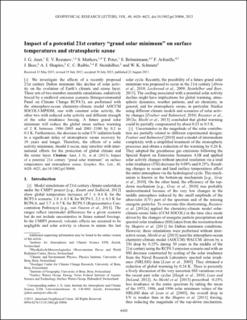Please use this identifier to cite or link to this item:
https://doi.org/10.21256/zhaw-3930| Publication type: | Article in scientific journal |
| Type of review: | Peer review (publication) |
| Title: | Impact of a potential 21st century “grand solar minimum” on surface temperatures and stratospheric ozone |
| Authors: | Anet, Julien G. Rozanov, E. V. Muthers, S. Peter, T. Brönnimann, S. Arfeuille, F. Beer, J. Shapiro, A. I. Raible, C. C. Steinhilber, F. Schmutz, W. K. |
| DOI: | 10.21256/zhaw-3930 10.1002/grl.50806 |
| Published in: | Geophysical Research Letters |
| Volume(Issue): | 40 |
| Issue: | 16 |
| Page(s): | 4420 |
| Pages to: | 4425 |
| Issue Date: | 2013 |
| Publisher / Ed. Institution: | Wiley |
| ISSN: | 0094-8276 1944-8007 |
| Language: | English |
| Subject (DDC): | 551: Geology and hydrology |
| Abstract: | We investigate the effects of a recently proposed 21st century Dalton minimum like decline of solar activity on the evolution of Earth's climate and ozone layer. Three sets of two member ensemble simulations, radiatively forced by a midlevel emission scenario (Intergovernmental Panel on Climate Change RCP4.5), are performed with the atmosphere‐ocean chemistry‐climate model AOCCM SOCOL3‐MPIOM, one with constant solar activity, the other two with reduced solar activity and different strength of the solar irradiance forcing. A future grand solar minimum will reduce the global mean surface warming of 2 K between 1986–2005 and 2081–2100 by 0.2 to 0.3 K. Furthermore, the decrease in solar UV radiation leads to a significant delay of stratospheric ozone recovery by 10 years and longer. Therefore, the effects of a solar activity minimum, should it occur, may interfere with international efforts for the protection of global climate and the ozone layer. |
| Further description: | ©2013. American Geophysical Union. All Rights Reserved |
| URI: | https://digitalcollection.zhaw.ch/handle/11475/8844 |
| Fulltext version: | Published version |
| License (according to publishing contract): | Licence according to publishing contract |
| Departement: | School of Engineering |
| Organisational Unit: | Centre for Aviation (ZAV) |
| Appears in collections: | Publikationen School of Engineering |
Files in This Item:
| File | Description | Size | Format | |
|---|---|---|---|---|
| Anet_et_al-2013-Geophysical_Research_Letters.pdf | 446.16 kB | Adobe PDF |  View/Open |
Show full item record
Anet, J. G., Rozanov, E. V., Muthers, S., Peter, T., Brönnimann, S., Arfeuille, F., Beer, J., Shapiro, A. I., Raible, C. C., Steinhilber, F., & Schmutz, W. K. (2013). Impact of a potential 21st century “grand solar minimum” on surface temperatures and stratospheric ozone. Geophysical Research Letters, 40(16), 4420–4425. https://doi.org/10.21256/zhaw-3930
Anet, J.G. et al. (2013) ‘Impact of a potential 21st century “grand solar minimum” on surface temperatures and stratospheric ozone’, Geophysical Research Letters, 40(16), pp. 4420–4425. Available at: https://doi.org/10.21256/zhaw-3930.
J. G. Anet et al., “Impact of a potential 21st century “grand solar minimum” on surface temperatures and stratospheric ozone,” Geophysical Research Letters, vol. 40, no. 16, pp. 4420–4425, 2013, doi: 10.21256/zhaw-3930.
ANET, Julien G., E. V. ROZANOV, S. MUTHERS, T. PETER, S. BRÖNNIMANN, F. ARFEUILLE, J. BEER, A. I. SHAPIRO, C. C. RAIBLE, F. STEINHILBER und W. K. SCHMUTZ, 2013. Impact of a potential 21st century “grand solar minimum” on surface temperatures and stratospheric ozone. Geophysical Research Letters. 2013. Bd. 40, Nr. 16, S. 4420–4425. DOI 10.21256/zhaw-3930
Anet, Julien G., E. V. Rozanov, S. Muthers, T. Peter, S. Brönnimann, F. Arfeuille, J. Beer, et al. 2013. “Impact of a Potential 21st Century “Grand Solar Minimum” on Surface Temperatures and Stratospheric Ozone.” Geophysical Research Letters 40 (16): 4420–25. https://doi.org/10.21256/zhaw-3930.
Anet, Julien G., et al. “Impact of a Potential 21st Century “Grand Solar Minimum” on Surface Temperatures and Stratospheric Ozone.” Geophysical Research Letters, vol. 40, no. 16, 2013, pp. 4420–25, https://doi.org/10.21256/zhaw-3930.
Items in DSpace are protected by copyright, with all rights reserved, unless otherwise indicated.